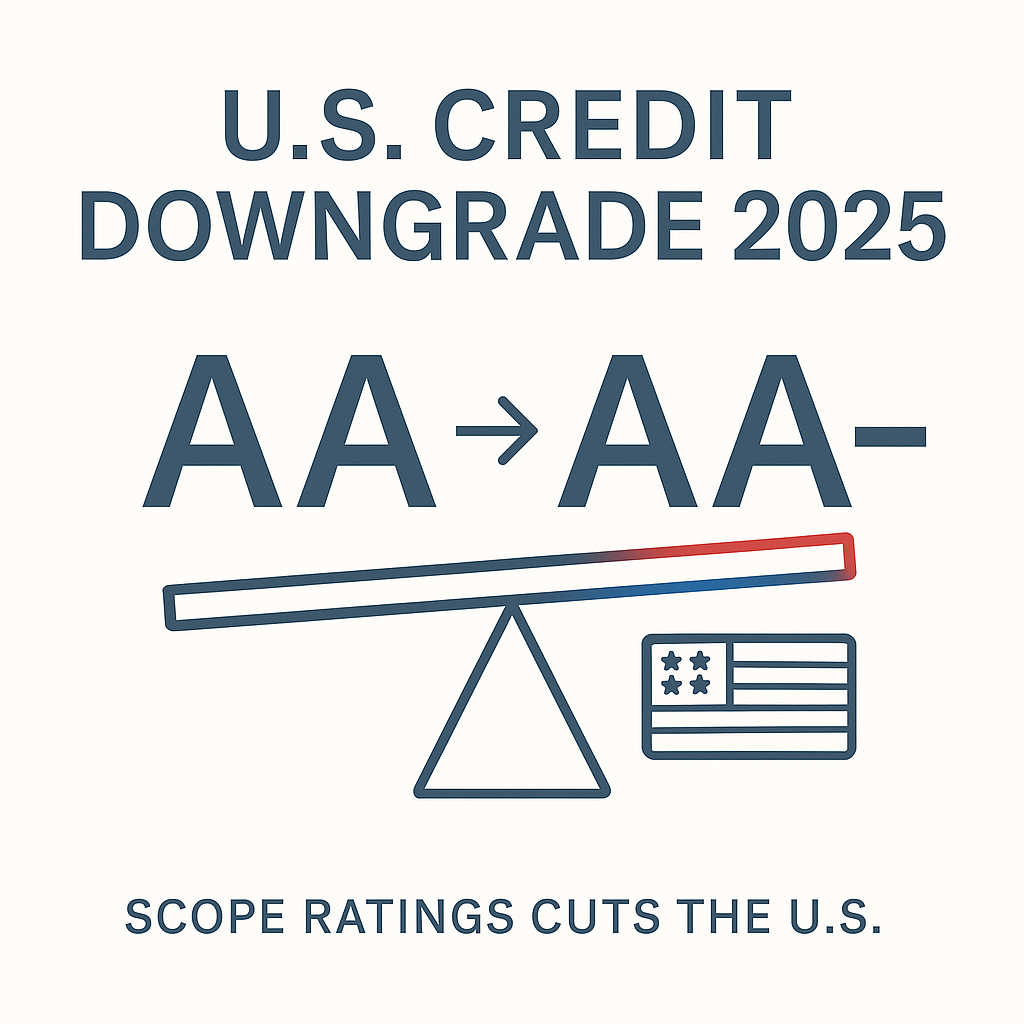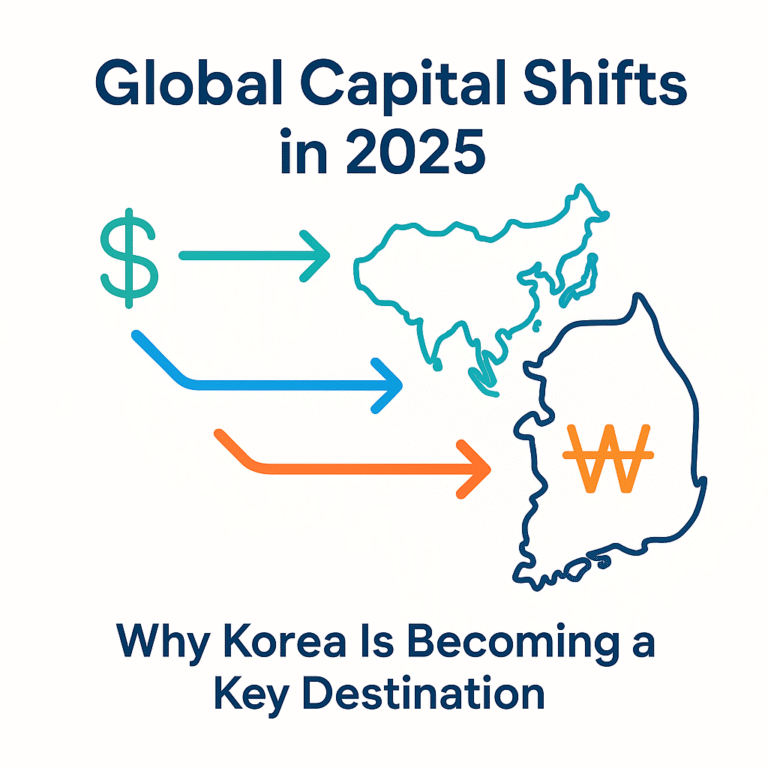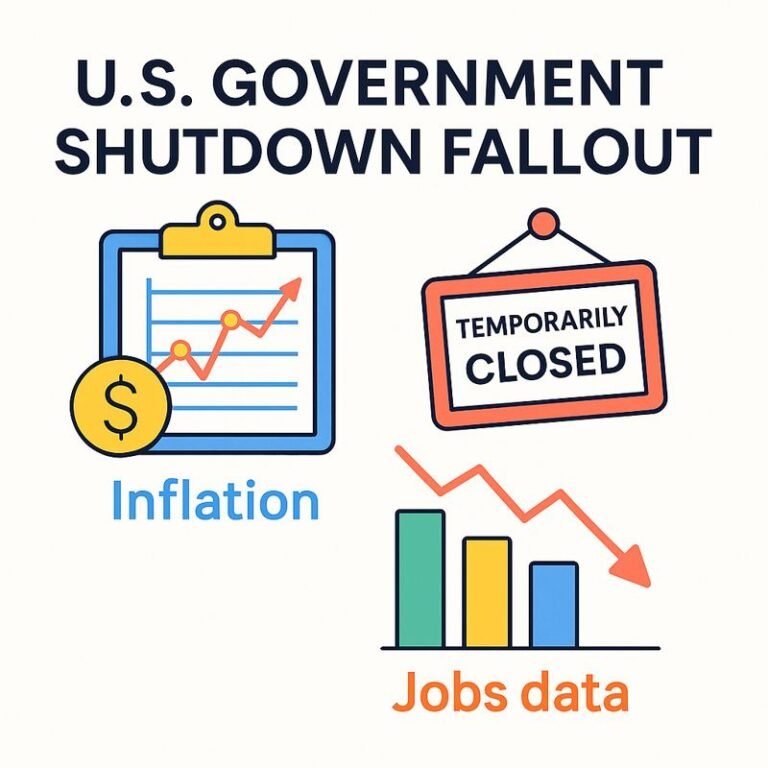U.S. Credit Rating Downgrade 2025: Why Scope Ratings Cut the United States to AA- and What Investors Should Know
Scope Ratings lowered the U.S. sovereign credit rating to AA- in October 2025. Explore the causes, market impact, and investor take-aways now.
TiKey Takeawaystle
✔ On October 24, 2025, Scope Ratings cut the United States’ long-term issuer rating from AA to AA-.
✔ The downgrade stems from persistent federal budget deficits, rising interest-cost burdens, and weakening governance structures.
✔ Investors should monitor U.S. Treasury yields, dollar volatility, and global asset allocation adjustments.
✔ For global and Korean investors, this signals a need to revisit reliance on U.S. sovereign assets and review portfolio diversification.
Why Did the United States’ Credit Rating Get Downgraded? Scope’s Decision Explained
In an event that caught global attention, Berlin-based credit agency Scope Ratings announced on October 24, 2025 that it had lowered the United States’ long-term foreign and local-currency issuer rating from AA to AA-, and revised the outlook to Stable.
Scope cited three core factors behind the decision:
- Sustained deterioration in public finances with deficits well above pre-pandemic norms.
- A growing burden of interest payments that eats into fiscal flexibility.
- Governance and policy-making weaknesses—political gridlock and challenges in executing long-term fiscal reform.
This move is not merely symbolic. When a major economy like the U.S. loses even one notch in its sovereign rating, it signals that the global credit market views its fiscal and institutional footing as less secure than before.
Structural Weakness: Rising Debt, Expanding Deficits and Fiscal Stress
The U.S. government’s fiscal situation has moved beyond short-term cyclical stress.
According to Xinhua’s summary of Scope’s report, the U.S. deficit reached about 8.0% of GDP in 2024, significantly above pre-pandemic averages around 4.8%. Scope projects the deficit to remain near 7.4% of GDP in 2025 and average about 7.8% during 2026-2030.
The debt-to-GDP ratio is projected to climb to roughly 140% by 2030 if no corrective policy measures are implemented. This is up from about 122% in 2024.
Such metrics matter because they speak to the government’s ability to service debt and manage future shocks. Higher debt means larger interest burdens; larger interest burdens reduce fiscal space; reduced fiscal space limits responses to recessions or crises.
Governance Risk: Political Standstill, Shutdowns and Eroding Policy Credibility
Beyond numbers, Scope highlighted governance as a key risk. The agency noted that policy-makingcertainty in the U.S. is undermined by partisan polarization and legislative deadlock.
For example, the October 1 2025 partial U.S. federal government shutdown reflected the inability to pass budget legislation in time. This incident influenced the rating agency’s view that “budgetary flexibility is constrained by high mandatory spending and tax cuts that limit adjustment options.”
In short, the downgrade reflects not only fiscal stress but a fundamental concern about how reliably the U.S. government can act when needed.
Credit Rating Agencies’ U.S. Ratings Compared: Where Does the “AA-” Fit?
|
Credit Agency |
Date of Recent Change |
Prior Rating |
New Rating |
Underlying Reason |
|---|---|---|---|---|
|
Scope Ratings |
2025-10-24 |
AA |
AA- |
Public-finance deterioration, governance concerns |
|
Moody’s Investors |
2025-05-16 |
Aaa |
Aa1 |
Rising debt, growing interest costs |
|
Fitch Ratings |
2023-08-01 |
AAA |
AA+ |
Protracted debt-ceiling risk, fiscal control issues |
|
S&P Global |
2011-08-05 |
AAA |
AA+ |
Earlier fiscal-governance concerns |
This comparison shows that the U.S. has been under pressure for years and that the downward trajectory spans multiple agencies. The shift by Scope to AA- is a continuation of that trend and spells a broader reassessment of U.S. sovereign risk.
Insights from Experts: “The Problem Is Political, Not Just Financial”
In its official statement, Scope Ratings noted:
“Sustained deterioration in public finances and a weakening of governance standards drive the downgrade.”
Similarly, the International Monetary Fund (IMF) recently warned that the U.S. must tackle its expanding deficits aggressively or face deeper instability in global capital markets.
The consensus: The issue at hand is less about one year’s budget and more about policy-making capacity, institutional resilience, and long-term fiscal strategy.
Investor Implications: What the U.S. Credit Downgrade Means for Bonds, Dollar & Portfolio Strategy
Rising Treasury Yields
A lower credit rating tends to push yields higher because investors demand extra compensation for risk. After the downgrade, 10-year U.S. Treasury yields may rise further from the ~4.7% level.
Dollar Volatility
The U.S. dollar has been a safe-haven asset for decades. If investor confidence in U.S. fiscal health falters, dollar strength may be tested. In the near term, safe-haven inflows may lift the dollar, but longer term, weak fundamentals could weigh.
Equity & Sector Risks
Higher yields and tighter fiscal conditions tend to hurt growth stocks and sectors sensitive to interest rates—such as technology. Banks and insurers, heavily exposed to bond markets, may also face margin pressure.
Portfolio Strategy for Non-U.S. Investors
- Re-evaluate heavy allocations to U.S. Treasuries.
- Consider diversifying into non-U.S. sovereign debt, regional stocks, or commodities.
- Use gold or other hedges to offset rising credit and interest-rate risk.
Implications for Korean and Global Investors: Time to Re-check U.S. Dependency
For Korean investors, U.S. sovereign assets have long been seen as safe refuge. This downgrade challenges that assumption.
- High exposure to U.S. dollar assets may mean higher correlation to credit and fiscal risk.
- Global diversification becomes more relevant: Europe, Asia, emerging markets present alternative opportunities.
- Stringent review of dollar-based liabilities and overall portfolio sensitivity to U.S. rate moves is advised.
What’s Next: Scenarios, Risks & Things to Watch
- Additional downgrades possible: Scope left the outlook at Stable, but if deficits worsen and policy gridlock continues, further downgrades by other agencies are plausible.
- Policy response crucial: Tax reform, spending rationalization, or credible debt-ceiling mechanisms could restore confidence—but require political consensus.
- Macro risks to monitor: Inflation resurgence, rapid rate hikes, or external shocks (e.g., geopolitical tension) may amplify fiscal stress.
- Global reaction: Shift in capital flows, reserve-currency re-evaluations, and changes in sovereign spread pricing are all on the table.
The October 2025 downgrade of the U.S. sovereign credit rating by Scope Ratings is more than a numerical change—it signals a structural shift in how global markets view U.S. fiscal and governance strength. For investors, it is time to reassess exposure to U.S. bonds, the dollar, and growth-dependent assets.
References
- Scope Ratings: “Scope downgrades the United States of America’s credit ratings to AA- and revises Outlooks to Stable.”
- Reuters: “Scope downgrades U.S. credit rating on public finance, governance deterioration; revises outlook to ‘stable.’”
- Xinhua: “Scope downgrades U.S. credit ratings to AA-, citing public finances deterioration.”







